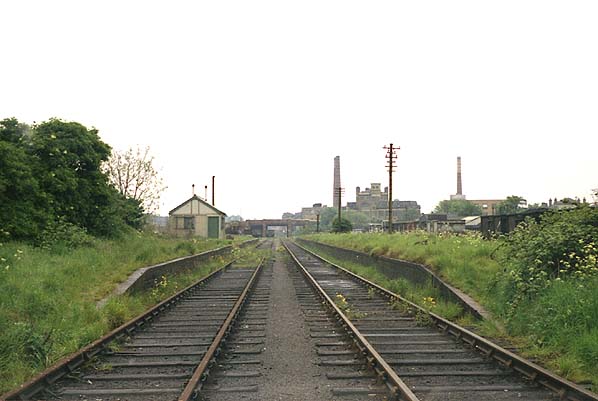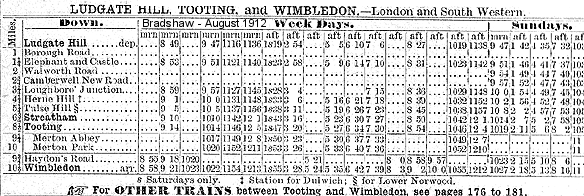|
Notes: Merton Abbey consisted of two platforms with the stationmaster's house and booking office on the 'up' platform and a small brick waiting shelter on the 'down' platform. The station closed on 1st January 1917 as an economy measure during WW1 and reopened on 27th August 1973.
After closure to passengers in 1929 the station continued to handle freight traffic until 1st May 1975, after final closure the track was quickly lifted.
In the mid 1980's the station site was excavated by an archaeological team from the London Museum looking for the foundations of Merton Priory which stood on the site (it was never an abbey). Foundations were found and part of the Chapter House has been preserved under Merantun Way and can be viewed from a subway under the road.
BRIEF HISTORY OF THE TOOTING MERTON & WIMBLEDON RAILWAY
The Tooting, Merton & Wimbledon Extension Railway obtained an Act on 19 July 1864. This was a nominally independent concern with powers to make working arrangements with both the LB&SCR and the LSWR but a further act of 1865 dissolved the independent company and vesting its line jointly in the LSWR and LBSCR. The Tooting, Merton & Wimbledon Railway opened on 1 October 1868 from Streatham Junction (on the LBSCR Peckham Rye to Sutton line dating from the same day) to Wimbledon, which was approached from two directions by lines diverging at Tooting Junction, one coming into the town from the north-east, the other from the south¬east after forming a junction with the Wimbledon & Croydon Railway at Merton. The northern arm of the loop line reached Wimbledon via a station at Hayden Lane.
 |
The opening of the TMWR via Merton Abbey saw the doubling of the WCR between Wimbledon and the junction at Lower Merton. The line was double track throughout, the line through Merton being justified by promise of freight traffic from the copper mills at Merton Abbey where a siding was provided. At first only LBSCR trains used the TM&W, working |
between London Bridge and Wimbledon by both routes to and from Tooting Junction, but the 1865 Act had given the LSWR running powers to Tulse Hill and on 1 January 1869 a Kingston to Ludgate Hill service was started, this utilised both arms of the TM & W. although most of the twelve daily trains between Kingston and Ludgate Hill ran via the Merton line.
There was two intermediate station on the Merton line at Merton Abbey and Lower Merton and one on the northern branch at Haydons Road, both opened with the line. Lower Merton was at the junction with the W & CR, initially there was only platforms on the Tooting line but a platform was later added on the Croydon line opening on 1st November 1870.
In 1893 of the 16 down trains between London Bridge and Tooting Junction, five continued to Wimbledon via Merton Abbey, returning via Haydon’s Road, the remainder reversing this route. Both routes were well used during rush hours but with the introductions of trams and motor buses after 1910 there was little off peak traffic.
Initially World War I brought few changes to passenger services until 31st December 1916 when services on both sides of the loop were withdrawn to make resources available for essential war transport. The passenger service resumed on 27 August 1923 at a reduced frequency. In 1929 the northern loop was electrified but following the opening of the Northern Line extension to Morden the southern loop had lost much of its traffic to the underground with commuters using Colliers Wood rather than Merton Abbey which closed from 3rd March 1929 when the loop was relegated to freight traffic only From the following day, electric trains ran half-hourly between Wimbledon and Holborn Viaduct seven days a week and the new electric trains quickly won back passengers from road transport.
| The Merton Abbey chord remained busy with freight, but the junction at the Tooting end was severed on 10 March 1934, The up track was removed and the section was worked as a long siding from Merton Park, with control by telephone from instruments in the Merton Abbey goods office. Occasional special passenger workings visited Merton Abbey. In 1936 a |
 |
supplement to the working timetable indicated that the down platform could be used by excursion trains, but the line was not to be negotiated at more than 5mph, under the supervision of a pilotman.
In the late 1920s and 1930s, Merton saw industrial expansion and a siding was laid from the Merton Abbey track into the new Lines Brothers Triang toy factory in Morden Road. Other private sidings served the Eyre Smelting Works and the New Merton Board Mills at Merton Abbey. As late as 1960 there were still two return goods workings daily from Norwood to Merton Abbey and one on Saturdays to Hackbridge, but with factory closures and increased use of road transport, loadings fell, and after the last revenue train ran coal down to Merton Abbey on 1 May 1975 the track was quickly lifted.
The section of the TM & WR route east of Morden Road was used to construct Merantun Way (A24) in the early 1990's. The road was built to relieve traffic congestion on Merton High Street and was originally planned to continue to the west, along the route of the old railway to Kingston Road, with a flyover across Morden Road. This section of the route was never constructed although the space between the carriageways where Merantun Road meets Morden Road provides the space for a flyover bridge to be constructed. The track bed between Morden Road and Merton Park Station is now a public footpath and nature reserve
Tickets from Michael Stewart. Bradshaw from Chris Hind. See also Peter Wrights Overground web site for more pictures of Merton Abbey Station.
Sources:
Click on station name for other stations on the Wimbledon - West Croydon line: Merton Park, Morden Road, Mitcham, Mitcham Junction, Beddington Lane, Waddon Marsh & West Croydon
See also the Tooting Merton & Wimbledon Railway: Tooting Junction and Haydons Road.
See also the St. Helier Estate Railway
(West Croydon, Mitcham Junction and Haydons Road are still open but are included for completeness) |

abbey_old2.jpg)

abbey21.jpg)


abbey7.jpg)
abbey12.jpg)
abbey17.jpg)
abbey20.jpg)




 Home Page
Home Page